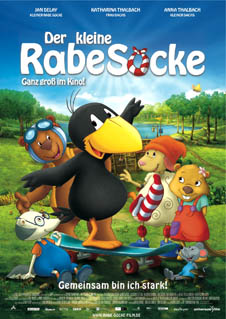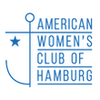
Starts September 6
Original language: German
 Socke is a bird, a black raven with a bright yellow bill. He takes his name from a red-and-white-stripped sock that he wears on his left foot. It is so much a part of him that he often talks to it much like a baby’s security blanket. He is the star of a series of children’s books which first came out in 1996 and have since been translated into many languages. There are several short animated versions of Socke, but this is the first full-length film.
Socke is a bird, a black raven with a bright yellow bill. He takes his name from a red-and-white-stripped sock that he wears on his left foot. It is so much a part of him that he often talks to it much like a baby’s security blanket. He is the star of a series of children’s books which first came out in 1996 and have since been translated into many languages. There are several short animated versions of Socke, but this is the first full-length film.
During an imprudent game on a dam, he and his friend poke holes until the water flows into their forest, threatening to flood the house of Frau Dachs (Mrs. Badger). The only solution is to locate the original architects: the beavers. Socke and his friends Wolle (a sheep) and Eddi Bear take to the road. Along the way, they lose Wolle to a sheep dog overseer who thinks she’s a part of his herd. He locks her up in a shed with his own sheep, who can hardly believe her tales of another world beyond their small compound. She teaches them that sheep are “wild and dangerous.” In the end, with the encouragement of Fritzi, a small beaver girl, the dam is repaired in a highly original fashion and all celebrate.
Naturally, there are other adventures around the main story, as well as more animals, each with its own personality. Socke, the star, demonstrates several human personality traits such as showing off, twisting the facts to his advantage, or pouting in his nest (which is a terrific tree house any child could wish for). Still he is always cheerful and friendly, even if he does have an unrealistic notion of his own talents and often fails to deliver. Everyone loves him and forgives his small weaknesses.
I was privileged to see Der Kleine Rabe Socke at its premiere in Hamburg’s Streit’s Cinema right on the beautiful Alster Lake. The cinema was full with probably 300 children, approximately three- to seven-years-old, and their parents. Each received an original Socke cup full of soft drink, an originally decorated bag of popcorn, as well as posters and coloring books. A Socke impressionist posed for photos with the children. At least ten members of the cast and production posed for photographs for the press, e.g., director Ute von Münchow-Pohl and Jan Delay who was the voice of Socke. (Delay is a well known musician with a porkpie hat; perhaps this will open a new acting career). This highly charged atmosphere enhanced the excitement and the audience was prepped to enjoy the film, which it seemed to do. German animated films are not Walt Disney, nor Hollywood, in that they seem to refrain from silliness for the sake of keeping the action high-pitched. It’s all right to have slow moments.This might be boring for anyone expecting on-going tension. On the whole it is a fun story about a bird who could be any child that you might know. If I were a parent of a small child, I would read some of the books with him and then see the film.
